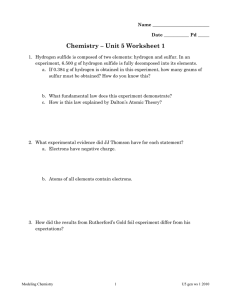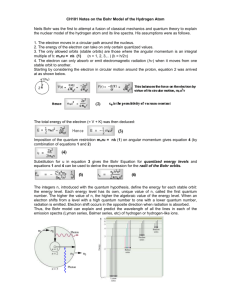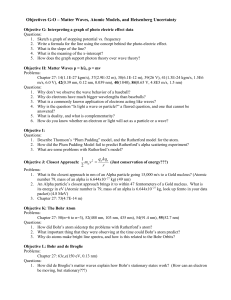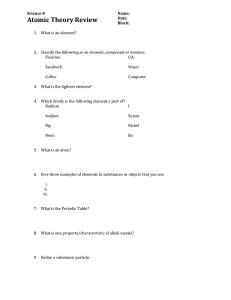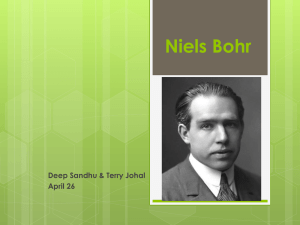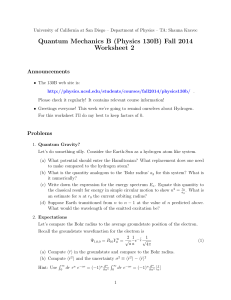The Atom The Geiger-Marsden Experiment
advertisement
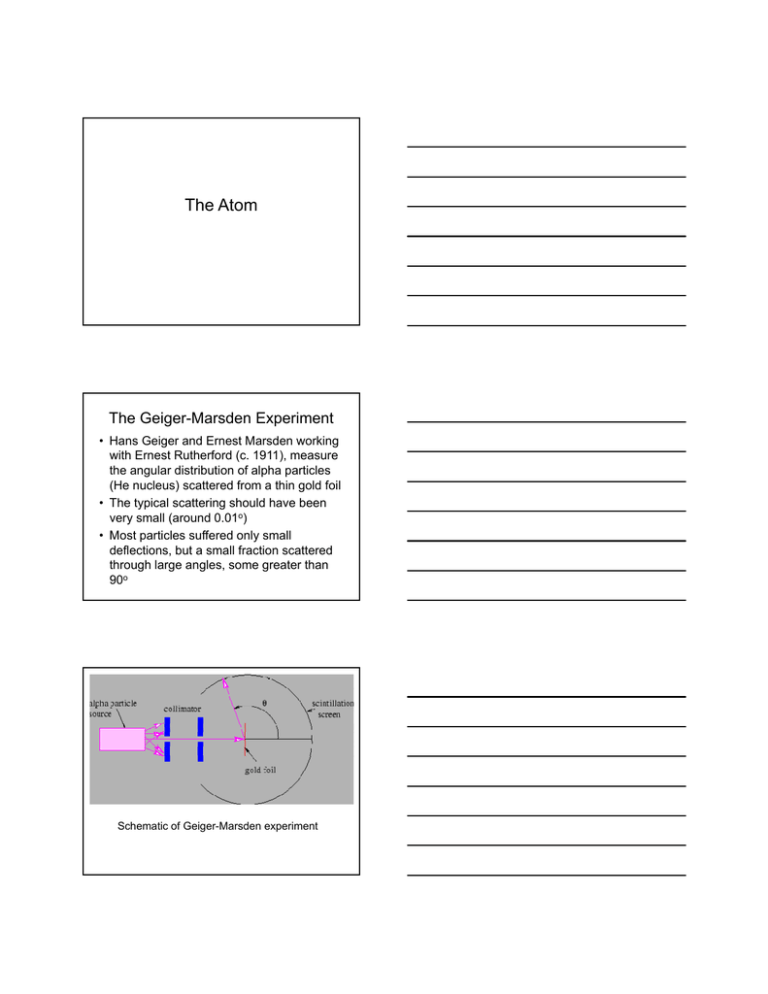
The Atom The Geiger-Marsden Experiment • Hans Geiger and Ernest Marsden working with Ernest Rutherford (c. 1911), measure the angular distribution of alpha particles (He nucleus) scattered from a thin gold foil • The typical scattering should have been very small (around 0.01o) • Most particles suffered only small deflections, but a small fraction scattered through large angles, some greater than 90o Schematic of Geiger-Marsden experiment • Rutherford calculated theoretically the number of alpha particles expected at a particular scattering angle based on Coulomb’s force law • His results agreed with the experimental data if the positive atomic charge was confined to a region of linear size of approximately 10-15 m • This and subsequent experiments confirmed the existence of a small massive positive nucleus inside the atom Calculation • Consider an alpha particle of charge q shot head on towards a stationary nucleus of charge Q • Initially the total energy is equal to the kinetic energy of the alpha particle, Ek • We take the separation distance to be large so that there is no potential energy • At the point of closest approach, a distance d from the center of the nucleus, the alpha particle stops and is about to turn back • At this point, the total energy is the electrostatic potential energy given by Ek qQ d • Then, by conservation of energy qQ d qQ d k Ek Ek k • Assuming a kinetic energy for the alpha particle (q=2e) of 2 MeV directed at a gold nucleus (Q=79e) the result gives d=1x10-13m • This is outside of the range of the nuclear force, so the alpha particle is simply repelled by the electrical force • As the energy of the incoming particle increases, the distance of closest approach decreases • The smallest it can get is the same order as the radius of the nucleus • Experiments show that the nuclear radius depends on the mass number (the number of protons and neutrons in the nucleus), A 1 R R0 A 3 Fermi radius R0 = 1.2x10-15 m Atomic Spectra • It had been observed early in the 19th century that the spectrum from excited gases was not continuous but discrete • Each gas produced its own unique line spectrum • Emission Spectra – The set of wavelength of light emitted by atoms of an element • Absorption Spectra – The wavelengths that are absorbed by the element used by the electrons to jump to a higher energy state • Johann Balmer (1885) discovered, by trial and error, that the wavelengths of the emission spectrum of Hydrogen were given by: 1 1 R 2 4 n 1 n 3,4,5,... Bohr Model • Bohr had studies in Rutherford’s lab for several months in 1912 and was convinced that Rutherford’s planetary model of the atom had validity • He felt that it must be related to the newly developing quantum theory • Bohr argued, that the electrons cannot lose energy continuously. But must do so in quantum “jumps” • Bohr postulated that electrons move in circular orbits, but only certain orbits are allowed, without radiating energy – This violates classical ideas since accelerating charges are supposed to emit EM waves • He called these specific orbits stationary states • Light is emitted when an electron jumps from a higher stationary state to one of lower energy • When the electron jumps a single photon of light is emitted whose energy is given by hf E • Bohr set out to determine what energies these orbits would have in Hydrogen • He found that his theory would agree with Balmer’s formula if he assumed that the electron’s angular momentum is quantized and equal to an integer n times h/2π L I For a single particle of mass m moving in a circle or radius r with speed v v I mr 2 and r v L mr 2 mvr r • Bohr’s quantum condition is mvr nh 2 Where n is the principal quantum number of the orbit • There was no theoretical foundation for the equation • Bohr had searched for some “quantum condition” but had not found anything that worked with his experiments • Bohr’s reason for the equation was simply that “it worked” – Note that while the equation works for hydrogen it does not work for other atoms • Calculating the potential and kinetic energies of the electrons in a Hydrogen atom using Bohr’s model gives us E 13.6 eV n2 • The quantum number n that labels the orbital radii also labels the energy levels • The energy is measured in electron volts (as is customary in particle and quantum physics) • The lowest energy state (n=1) is referred to as the ground state • The binding energy or ionization energy is 13.6 eV (moving from E1=-13.6 eV to E=0) • Bohr’s model was successful because – It explained the emission line spectra of hydrogen – It explained the absorption line spectra – It ensured the stability of atoms • It did this by decree: the ground state is the lowest state for an electron, it cannot go lower and emit more energy – It accurately predicted the ionization energy of hydrogen • However, the Bohr model was not as successful with other atoms
